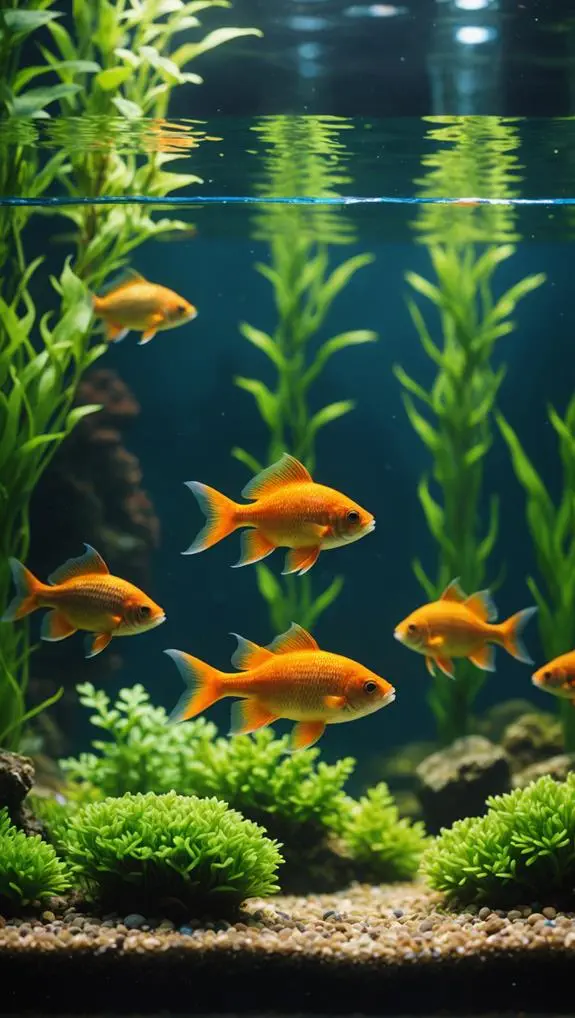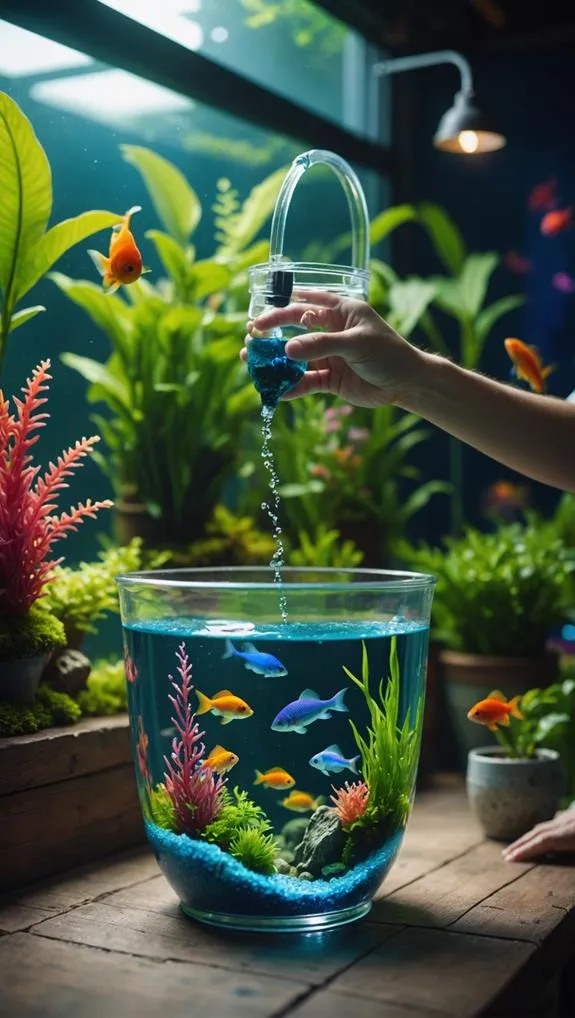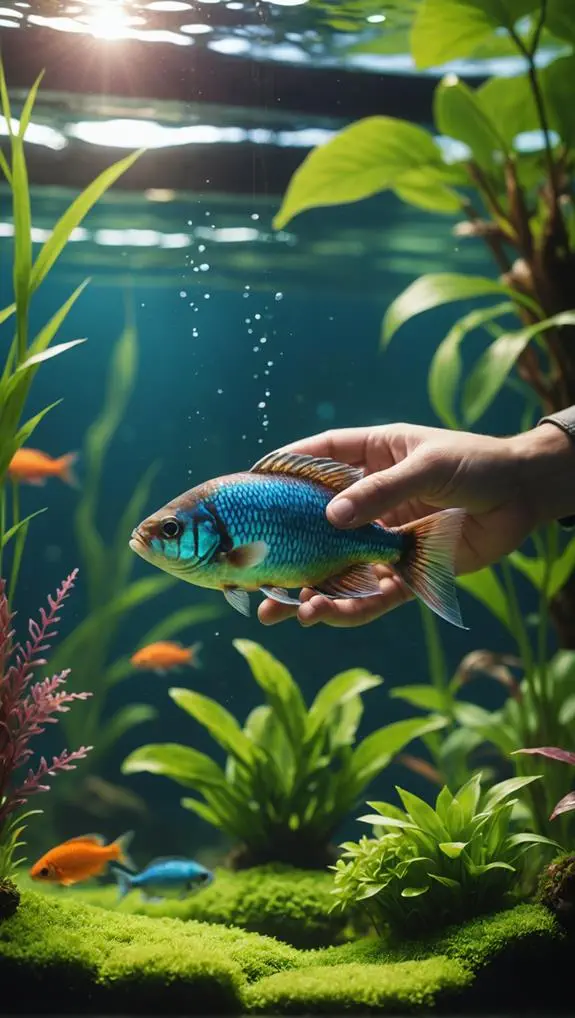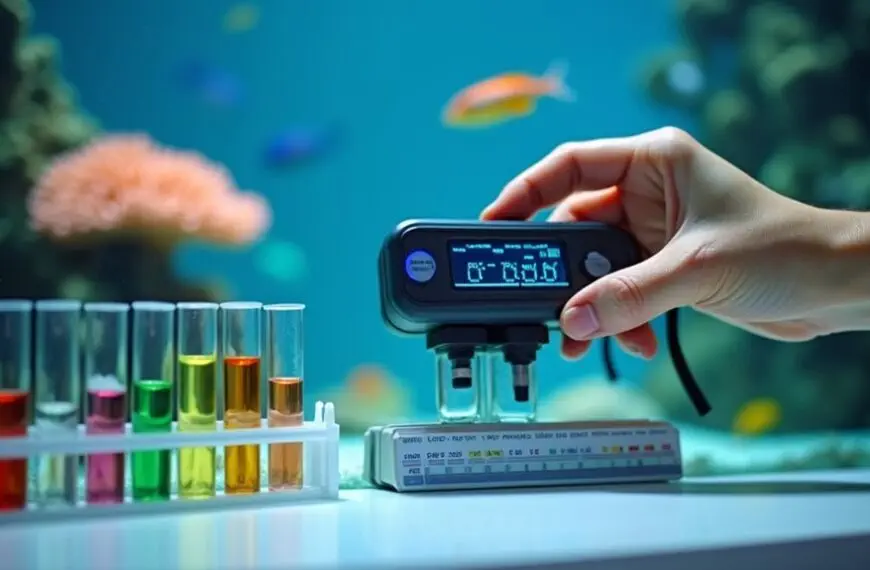You should change your fish tank water regularly to keep your underwater friends safe and sound, just like you wouldn't want to swim in a muddy pool! Regular water changes help reduce harmful substances like ammonia and nitrates that can stress your fish out. It also replenishes essential minerals they need to thrive. Aim for a weekly change of about 10-20% of the water to maintain a clean environment. Your fish will thank you with happy fishy dances, and you'll avoid worrying about illness or stress. Stick around, and you'll find out some handy tips to make this task a breeze!
Contents
- 1 Benefits of Regular Water Changes
- 2 Understanding Nitrate Levels
- 3 Ideal Water Change Frequency
- 4 Impact of Bio-load on Changes
- 5 Steps for Effective Water Change
- 6 Water Quality Testing Techniques
- 7 Handling Fish During Changes
- 8 Alternative Maintenance Strategies
- 9 Frequently Asked Questions
- 10 Final Thoughts
Benefits of Regular Water Changes
Regular water changes are essential for maintaining a healthy aquarium environment. Imagine your fish swimming happily in clean water; that's what regular water changes can do! By changing the water in your freshwater tank, you significantly improve water quality by reducing harmful substances like ammonia and nitrites that build up over time.
These pesky pollutants often come from fish waste and uneaten food, and nobody wants that lurking around. Plus, you're not just clearing out the bad stuff; you're also replenishing essential minerals and micronutrients. These contribute to the overall health of your fish and plants, making your tank a thriving ecosystem.
And let's not forget about beneficial bacteria—they love a clean environment, too! When you stick to a schedule for regular water changes, you can boost fish growth and help reduce stress-related behaviors. It's like a spa day for your aquatic buddies!
Also, while you're at it, you get a chance to observe your fish and spot any health issues early on. So, roll up those sleeves, and let's make your aquarium a vibrant underwater paradise!
Understanding Nitrate Levels
Nitrate levels are crucial to maintaining a healthy aquarium, and they should ideally stay below 40 parts per million (ppm) for most freshwater fish species. If you let those levels rise too high, it can lead to stress, illness, or even worse for your finned friends.
Regular water changes are your best ally in keeping nitrate levels in check, as they help prevent the accumulation of fish waste and uneaten food.
Here are a few key points to consider:
- Test regularly: Frequent testing of nitrate levels ensures you catch any spikes before they become a problem.
- Know your bio-load: The number of fish and the amount of food you provide directly influence nitrate production, so keep an eye on that!
- Act promptly: If nitrates hit 10 ppm or higher, it's time for a water change to help restore that all-important water quality.
Ideal Water Change Frequency

To maintain a healthy aquarium, you should establish a water change routine that suits your tank's specific needs.
For freshwater tanks, a good rule of thumb is to aim for a water change every week, replacing about 10-20% of the water. This keeps your fish healthy and helps prevent nitrate levels from skyrocketing above 40 parts per million.
If you've got a heavily stocked tank, you might need to bump up those weekly water changes to keep things in check.
Remember, more fish equals more waste, and that means more frequent maintenance.
Some seasoned aquarists might suggest less frequent changes for well-established tanks, but don't let that fool you—monitoring water parameters is crucial.
Ultimately, the best schedule is the one that meets your tank's unique needs.
So, don't be afraid to tailor your routine!
Think of water changes as a little spa day for your fish, helping them thrive in their underwater paradise.
And trust me, your aquatic friends will thank you for it—who doesn't love a clean home?
Impact of Bio-load on Changes
Bio-load plays a crucial role in determining how often you need to change your aquarium water.
It refers to the total amount of waste produced by your fish, and trust me, the more fish you have, the higher the bio-load. This waste can mess with your tank water quality, so understanding it's key to keeping your aquatic friends healthy.
Here are some factors to consider regarding bio-load and water changes:
- The number of fish you keep directly impacts waste production.
- The amount of food you give them also affects nitrate levels.
- Regular testing of nitrate levels can help you gauge when it's time for a change.
If your tank is generating, say, 10 ppm of nitrates weekly, you'll want to change the water after about four weeks to avoid harmful buildup.
By keeping an eye on your bio-load, you can adjust your feeding practices and fish populations. This not only promotes a healthier environment but can also help you become a more responsible aquarium keeper.
After all, your little underwater pals depend on you for a clean and safe home!
Steps for Effective Water Change

Regularly changing the water in your fish tank is essential for maintaining a healthy aquatic environment. To start, aim for a 10%-15% water change weekly in small tanks, and about 20% for larger ones. This keeps harmful chemicals in check and ensures your fish thrive.
Before you dive in, let's prep! Allow new tap water to sit for three days or add a dechlorinator to keep your finned friends safe. Don't forget to disconnect equipment like filters to avoid any mishaps during the change. Gather your supplies—siphons, buckets, and sponges are all you need.
When you're ready to change the water, use a gravel siphon to remove debris, but be careful not to take out more than 25% of the water in one go. It's like giving your tank a gentle bath!
As you refill, do it slowly with the treated water, and remember to check water levels, pH, and salinity. This helps ensure a smooth transition back to the original environment.
Water Quality Testing Techniques
While you may enjoy the vibrant colors and movements of your fish, ensuring their health requires vigilant water quality testing techniques. Regular testing is crucial for monitoring key parameters like nitrate levels, pH, and hardness. By keeping a close eye on these factors, you can catch any imbalances before they turn into bigger problems.
To make your testing routine effective, consider these tips:
- Use a reliable water testing kit, especially one with liquid testing solutions, for accurate readings.
- Test your water at least once a week to stay ahead of any potential issues.
- Aim to keep nitrate levels below 40 parts per million (ppm) to safeguard your fish's health.
Consistency is key! By establishing a routine for water quality testing, you can better plan your water changes based on actual data. This not only helps maintain a healthy environment but also reduces stress for your aquatic friends.
Handling Fish During Changes

When you're changing your fish tank water, it's best to leave the fish inside to keep their stress levels low.
They're already in their cozy home, and removing them can upset their little world, causing all sorts of fish drama!
Minimize Stress Levels
During water changes, keeping your fish in the tank can significantly minimize their stress levels. Fish thrive in their familiar environment, and when you leave them undisturbed, you help them maintain their sense of security.
Removing them can lead to anxiety and disrupt their established territories, which isn't good for their health.
Here are a few tips to keep in mind during water changes to reduce stress:
- Gradual Water Changes: Change about 10%-15% of the water at a time. This helps prevent sudden shifts in water chemistry, which can be shocking for your fish.
- Minimize Movement: Avoid sudden movements around the tank. Quick actions can make your fish feel like they're in a fishy horror movie!
- Observe Behavior: Keep an eye on your fish during the process. If they seem agitated, slow down and give them some space.
Maintain Familiar Environment
Keeping your fish in their tank during water changes is a key part of maintaining their familiar environment. When you need to perform a water change, that sense of home is crucial for their comfort.
If you suddenly remove your fish, they might experience shock, and nobody wants a panicked fish swimming around!
Instead, change your water gradually, replacing no more than 25% at a time. This approach helps keep things stable and familiar for your aquatic friends.
Plus, maintaining the same water parameters—like temperature and pH—when adding fresh water is essential. It's like giving your fish a warm hug instead of a chilly surprise!
Prevent Territorial Disruption
Stress can quickly escalate in your aquarium if you disrupt your fish's established territories during water changes. Every time you change water, it's crucial to keep your fish in their familiar environment. Handling them can confuse their social dynamics and lead to aggression. You want to maintain harmony in your tank, after all!
Here's how you can help prevent territorial disruption:
- Avoid moving fish: Keeping them in place helps maintain their comfort and reduces stress.
- Preserve beneficial bacteria: By not disturbing the tank too much, you keep the healthy bacteria thriving, which is essential for your fish's well-being.
- Support natural routines: Allow your fish to continue their foraging behavior without interruption, promoting a stable ecosystem.
When you change water, think about your fish and plants. Keeping things steady helps prevent fluctuations in water chemistry too.
Alternative Maintenance Strategies
When it comes to maintaining a healthy aquarium, alternative strategies can significantly reduce the frequency of water changes. You don't have to be a fish whisperer to keep your tank thriving!
By utilizing live plants, you can create a mini-ecosystem that naturally absorbs nitrates, reducing the need for constant water to clean. Think of it as a stylish natural filter!
Implementing a well-designed filtration system also helps minimize waste and toxins. This means you can stretch those intervals between changing the water without compromising your Aquarium Fish's happiness.
Adding airstones can boost oxygen levels while keeping the water circulating—almost like a spa day for your fish!
Regularly monitoring the water parameters is key. You'll get a better sense of when changing the water is genuinely necessary.
This tailored approach not only saves you time but also keeps your fish healthy and vibrant. Plus, it gives you more opportunities to enjoy watching them swim without worrying about the water top looking murky.
Frequently Asked Questions
What Happens if You Don't Change Fish Tank Water?
If you don't change fish tank water, you'll risk poor water quality, harming fish health. Algae growth can spiral out of control, complicating tank maintenance and jeopardizing the well-being of your aquatic friends.
How Often Should Fish Tank Water Be Changed?
You should change your fish tank water weekly, about 10-15%, to maintain water quality. This maintenance routine promotes fish health, reduces algae growth, and ensures a vibrant environment for both fish and plants.
Why Is It Important to Change Aquarium Water?
Changing aquarium water is vital for maintaining water quality, ensuring fish health, and controlling nitrate levels. Regular changes help prevent algae growth, creating a healthier environment where your fish thrive and flourish.
How Long Can You Go Without Changing Fish Tank Water?
You can't ignore fish tank maintenance for too long. Generally, you shouldn't go more than two to four weeks without changing water. High ammonia levels can jeopardize fish health and compromise overall water quality.
Final Thoughts
Changing your fish tank water regularly is like giving your aquatic friends a breath of fresh air. It keeps the environment healthy and happy, reducing harmful nitrates and making sure your fish thrive. Aim for those water changes based on your tank's bio-load, and don't forget to test the water quality. With a few simple steps, you can turn this task into a breeze. So, roll up your sleeves, and let's keep that underwater world sparkling!












